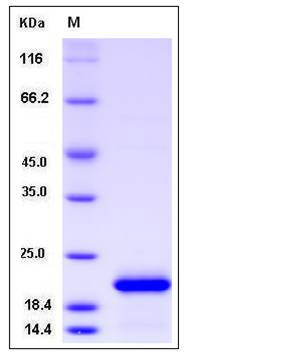Human FTH1 Protein
FHC,FTH,FTHL6,HFE5,PIG15,PLIF
- 100ug (NPP3877) Please inquiry
| Catalog Number | P13217-HNAE |
|---|---|
| Organism Species | Human |
| Host | E. coli |
| Synonyms | FHC,FTH,FTHL6,HFE5,PIG15,PLIF |
| Molecular Weight | The recombinant human FTH1 consists of 183 amino acids and has a calculated molecular mass of 21.2KDa as estimated in SDS-PAGE under reducing conditions. |
| predicted N | Met 1 |
| SDS-PAGE |  |
| Purity | > 95 % as determined by SDS-PAGE |
| Protein Construction | A DNA sequence encoding the human FTH1 (P02794) (Met 1-Ser183) was expressed and purified. |
| Bio-activity | |
| Research Area | Developmental Biology |Metabolism |Vitamins / Minerals |
| Formulation | Lyophilized from sterile PBS, pH 7.5 1. Normally 5 % - 8 % trehalose and mannitol are added as protectants before lyophilization. Specific concentrations are included in the hardcopy of COA. |
| Background | FTH1 (ferritin, heavy polypeptide 1) is the heavy subunit of ferritin which is the major intracellular iron storage protein in prokaryotes and eukaryotes. It is composed of 24 subunits of the heavy and light ferritin chains. Variation in ferritin subunit composition may affect the rates of iron uptake and release in different tissues. A major function of ferritin is the storage of iron in a soluble and nontoxic state. Defects in ferritin proteins are associated with several neurodegenerative diseases. FTH1 gene has multiple pseudogenes. Several alternatively spliced transcript variants have been observed, but their biological validity has not been determined. FTH1 stores iron in a soluble, non-toxic, readily available form. It is important for iron homeostasis. It has ferroxidase activity. Iron is taken up in the ferrous form and deposited as ferric hydroxides after oxidation. It also plays a role in delivery of iron to cells. FTH1 mediates iron uptake in capsule cells of the developing kidney. |
| Reference |
